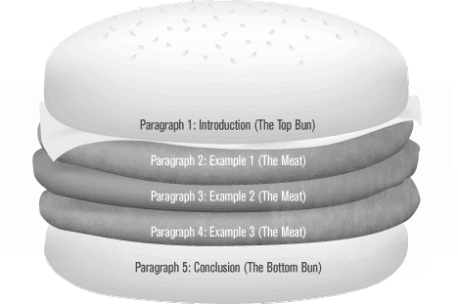The Essay is structured very much like a paragraph, but on a larger scale. Here are some Diagrams to illustrate:
∨ Introduction: General Theme that you want to focus on
* Specific Thesis (Topic Sentence for your whole Essay)
______
______ Body Paragraphs: Support and Develop your Argument
______
* Reintroduce thesis in the light of the evidence/explanation you have provided
∧ Conclude in more general terms.
In an essay, the introduction and conclusion serve very specific and important purposes. While the introduction narrows your topic and provides a clear focus for your essay, the conclusion generalizes your ideas.
The Introduction:
- Hooks your reader – creates interest, makes them want to read further
- Provides a road map – what is your topic, how you are going to proceed, the information
you will include - States your argument or your focus in a straightforward, confident way
The introduction of a paper serves two purposes: (1) It clarifies what the essay is about, and (2) it grabs the reader’s interest. The first goal is straightforward. The second one is more challenging.
Think about a few of your favorite movies. Now think about how they begin. You’ll probably discover that most movies begin with a dramatic or suspenseful opening. This is called a hook. Whether it’s a bit of slapstick humor or a violent encounter, the hook is intended to get you involved with the story right away and keep you watching. This same principle applies to essay writing. Now, this does not mean that you have to have a sensational opening, but it should interest the reader by showing—not telling.
Tips to Writing a Good Introduction:
– Think about the questions you will be answering in your essay
– What is the background information and general context your reader needs to understand before reading your essay
– Don’t be afraid to write your introduction last. Or write a tentative introduction and go back to change it later.
– Open with an attention grabber (story, example, quotation or question)
Let’s look at two versions of introductions to open a “Health Food for Kids” paper. Which one does a better job of introducing the essay? Which one would make you want to continue reading?
Example 1
Kids eat a lot of food that is really bad for them. They eat so much junk food that they get used to it and think it’s the way they’re supposed to eat. They eat candy and chew gum, too. In this essay I am going to write about different healthful foods that are also tasty. After all, “you are what you eat.”
Example 2
The sugar-coated purple cereal is disappearing as you slurp it down with chocolate milk. You jam some bubble gum in your mouth and hop on your bike. After hanging out at your friend’s house, you get hungry and head for the nearest fast-food joint for your hamburger, fries, and Coke. Does this sound familiar? There are too many kids who eat very unhealthful foods and do not know there are tasty foods that are not bad for them. So, do yourself a favor and read ahead for a healthful menu for breakfast, lunch, and dinner.
Example 3
What do you think of when you hear the words “health food?” Most kids think of food that tastes bad. After eating a health food candy bar, one of my friends said it tasted like cardboard. However, not all health food tastes bad. Here is a healthful menu for kids to choose from.
The Conclusion
The primary purpose of your conclusion is to bring your paper to an end, to “wrap it up.” Like introductions, good conclusions are interesting, leaving the reader with a strong sense of the paper. You should mention the points you just covered, but you don’t need to “spell them out.”
- Wrap it Up – reminder to your reader of what you have covered. Your reader should be able to put your essay down and explain very clearly what they just read about.
- “Re-state” – does not mean repeat. Review your main points, but use different words.
Here are some example from the “Health Food for Kids” paper.
Example 1
In conclusion, eating healthful foods makes a lot of sense. Those kids who continue to eat junk food all the time will only end up with bad eating habits when they get older. The foods for breakfast, lunch, and dinner that I have listed are great alternatives to unhealthful foods. You should always remember that “you are what you eat!”
Example 2
So, the next time you pop that jaw breaker into your mouth, the next time you eat oily potato chips for dinner, remember that there are tasty choices that won’t hurt your body. Melons taste a lot like candy if you haven’t been eating white sugar from those little packets every time you go to a restaurant. It might take a little getting used to, but once you begin to eat a healthful breakfast, lunch, and dinner, you’ll feel and look better.
